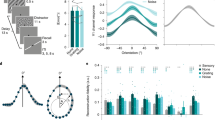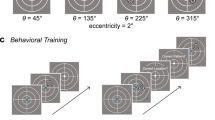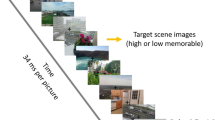Summary
Gaffan and Weiskrantz (1980) and Mishkin (1982) have shown that lesions to the inferior temporal visual cortex can impair the performance of serial visual recognition memory tasks. In order to provide evidence on whether the inferior temporal visual cortex contains a mechanism which enables memory to span the intervening items in a serial recognition task, or whether the inferior temporal cortex is merely afferent to such recent memory mechanisms, we analysed the activity of single neurons in the inferior temporal visual cortex and the adjacent cortex in the superior temporal sulcus in both delayed match to sample and serial recognition memory tasks. In the serial recognition task, various numbers of stimuli intervened between the first and second presentations of a stimulus. A considerable proportion (64/264 or 26%) of visually responsive inferotemporal neurons showed a different response to the “novel” and “familiar” presentations of a stimulus in the serial recognition memory task, and often a corresponding difference in response between the sample and match presentations of a stimulus in the delayed match to sample task. For the majority of neurons this difference was not sustained across even one intervening stimulus in the serial recognition task, and no neurons bridged more than 2 intervening stimuli. These results show that neurons in the inferior temporal cortex have responses which would be useful for a short term visual memory for stimuli, but would not be useful in recency memory tasks in which more than one stimulus intervenes between the first and second presentations of a stimulus. In this investigation, neurons were recorded both in the cortex on the inferior temporal gyrus (commonly called inferior temporal visual cortex, and consisting of areas TE3,TE2 and TE1 of Seltzer and Pandya 1978), and in the cortex in the adjacent anterior part of the superior temporal sulcus, in which a number of different temporal cortical visual areas have now been described (see Baylis et al. 1986).
Similar content being viewed by others
References
Ashford JW, Fuster JM (1985) Occipital and inferotemporal responses to visual signals in the monkey. Exp Neurol 90: 444–466
Baylis GC, Rolls ET, Leonard CM (1985) Selectivity between faces in the responses of a population of neurons in the cortex in the superior temporal sulcus of the monkey. Brain Res 342: 91–102
Baylis GC, Rolls ET, Leonard CM (1986) Functional subdivisions of temporal lobe neocortex. J Neurosci (in press)
Dean P (1976) Effects of inferotemporal lesions on the behaviour of monkeys. Psychol Bull 83: 41–71
Fuster JM, Bauer RH, Jervey JP (1981) Effects of cooling inferotemporal cortex on performance of visual memory tasks. Exp Neurol 71: 398–409
Fuster JM, Jervey JP (1981) Inferotemporal neurons distinguish and retain behaviorally relevant features of visual stimuli. Science 212: 952–955
Gaffan D (1974) Recognition impaired and association intact in the memory of monkeys after transection of the fornix. J Comp Physiol Psychol 86: 1100–1109
Gaffan D, Weiskrantz L (1980) Recency effects and lesion effects in delayed nonmatching to randomly baited samples by monkeys, Macaca mulatta. Brain Res 196: 373–386
Gaffan D, Harrison S, Gaffan EA (1986a) Visual identification following inferotemporal ablation in the monkey. QJ Exp Psychol 38B: 5–30
Gaffan EA, Harrison S, Gaffan D (1986b) Single and concurrent discrimination learning by monkeys after lesions of inferotemporal cortex. QJ Exp Psychol 38B: 31–57
Gallyas F (1979) Silver staining of myelin by means of physical development. Neurol Res 1: 203–209
Gross CG, Bender DB, Gerstein GL (1979) Activity of inferior temporal neurons in behaving monkeys. Neuropsychologia 17: 215–229
Merrill EG, Ainsworth A (1972) Glass-coated platinum-plated tungsten microelectrodes. Med Biol Eng 10: 662–672
Mikami A, Kubota K (1980) Inferotemporal neuron activities and color discrimination with delay. Brain Res 182: 65–78
Mishkin M (1978) Memory severly impaired by combined but not separate removal of amygdala and hippocampus. Nature 273: 297–298
Mishkin M (1982) A memory system in the monkey. Philos. Trans R Soc London B 298: 85–95
Rolls ET (1986) Information representation, processing and storage in the brain: analysis at the single neuron level. In: Changeux J-P, Konishi M (eds) Neural and molecular mechanisms of learning. Springer, Berlin Heidelberg New York Tokyo
Rolls ET, Baylis GC (1986) Size and contrast have only small effects on the responses to faces of neurons in the cortex in the superior temporal sulcus. Exp Brain Res (in press)
Rolls ET, Burton MJ, Mora F (1976) Hypothalamic neuronal responses associated with the sight of food. Brain Res 111: 53–66
Rolls ET, Judge SJ, Sanghera MK (1977) Activity of neurones in the inferotemporal cortex of the alert monkey. Brain Res 130: 229–238
Rolls ET, Perrett DI, Caan W, Wilson FAW (1982) Neuronal responses related to visual recognition. Brain 105: 611–646
Rolls ET, Sanghera MK, Roper-Hall A (1979) The latency of activation of neurons in the lateral hypothalamus and substania innominata during feeding in the monkey. Brain Res 164: 121–135
Sahgal A, Hutchinson R, Hughes RP, Iversen SD (1983) Effects of inferotemporal cortex lesions on Konorski delayed pair comparison in monkeys. Behav Brain Res 8: 361–374
Sahgal A, Iversen SD (1978) Categorization and retrieval after selective inferotemporal lesions in monkeys. Brain Res 146: 341–350
Sanghera MK, Rolls ET, Roper-Hall A (1979) Visual responses of neurons in the dorsolateral amygdala of the alert monkey. Exp Neurol 63: 610–626
Sato M, Kawamura M, Iwai E (1980) Responsiveness of inferotemporal units to visual pattern stimuli in monkeys performing discrimination. Exp Brain Res 38: 313–319
Schwartz EL, Desimone R, Albright TD, Gross CG (1983) Shape recognition and inferior temporal neurons. Proc Natl Acad Sci 80: 5776–5778
Seltzer B, Pandya DN (1978) Afferent cortical connections and architectonics of the superior temporal sulcus and surrounding cortex in the rhesus monkey. Brain Res 149: 1–24
Author information
Authors and Affiliations
Rights and permissions
About this article
Cite this article
Baylis, G.C., Rolls, E.T. Responses of neurons in the inferior temporal cortex in short term and serial recognition memory tasks. Exp Brain Res 65, 614–622 (1987). https://doi.org/10.1007/BF00235984
Received:
Accepted:
Issue Date:
DOI: https://doi.org/10.1007/BF00235984




